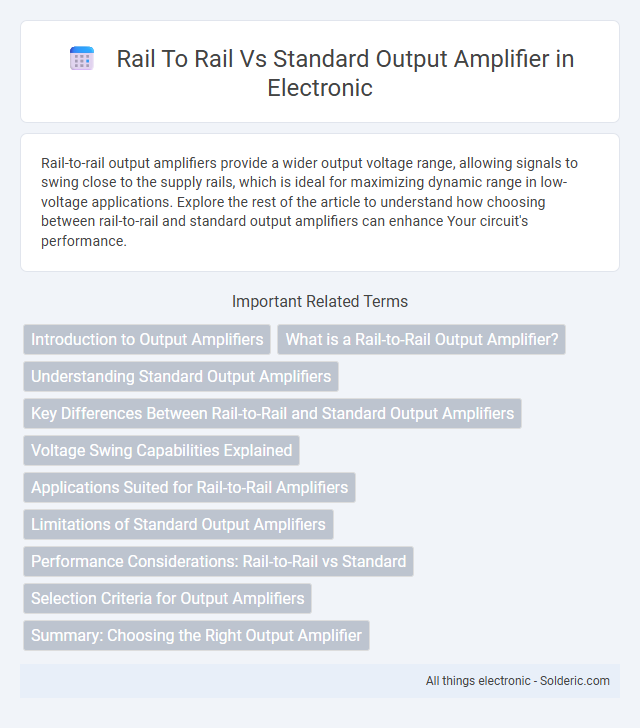Rail-to-rail output amplifiers provide a wider output voltage range, allowing signals to swing close to the supply rails, which is ideal for maximizing dynamic range in low-voltage applications. Explore the rest of the article to understand how choosing between rail-to-rail and standard output amplifiers can enhance Your circuit's performance.
Comparison Table
| Feature | Rail-to-Rail Output Amplifier | Standard Output Amplifier |
|---|---|---|
| Output Voltage Range | Close to supply rails (0 V to VCC) | Limited, does not reach supply rails |
| Output Swing | Maximized for full voltage range utilization | Restricted by transistor saturation limits |
| Application | Low voltage, battery-powered circuits, precision measurement | General purpose, standard voltage range designs |
| Power Supply Requirement | Works efficiently with single supply, low voltage | Often needs dual supply for full output swing |
| Complexity | More complex internal architecture | Simpler design |
| Cost | Generally higher | Lower |
| Linearity near rails | Better linearity and accuracy near supply rails | Reduced linearity near rails |
Introduction to Output Amplifiers
Output amplifiers serve as the final stage in analog signal processing, driving loads with the desired voltage and current levels. Rail-to-rail output amplifiers maximize output voltage swing by operating extremely close to their supply rails, enhancing dynamic range in low-voltage circuits. Standard output amplifiers, in contrast, typically have limited output swing, leaving a voltage gap between output voltage and supply rails, which may reduce signal fidelity in certain applications.
What is a Rail-to-Rail Output Amplifier?
A rail-to-rail output amplifier is designed to drive its output voltage as close as possible to the supply voltage rails, maximizing the signal swing within limited power supply constraints. This capability is essential in low-voltage and battery-powered applications where maximizing output dynamic range improves overall system performance. In contrast, standard output amplifiers typically cannot reach the supply rails, resulting in reduced output excursion and less efficient use of the available voltage range.
Understanding Standard Output Amplifiers
Standard output amplifiers typically have limited input and output voltage ranges, which restricts their ability to fully utilize the power supply rails. This limitation can result in decreased signal swing and reduced dynamic range compared to rail-to-rail amplifiers. Understanding these constraints helps in selecting the right amplifier to optimize Your circuit's performance where output voltage range is crucial.
Key Differences Between Rail-to-Rail and Standard Output Amplifiers
Rail-to-rail output amplifiers provide output voltage swings that extend close to the supply rails, maximizing the dynamic range in low-voltage applications. Standard output amplifiers have limited output swing, typically several volts away from the supply rails, which can reduce the usable signal range and affect performance in single-supply systems. Rail-to-rail amplifiers are ideal for battery-powered or low-voltage systems needing full signal utilization, whereas standard output amplifiers are suitable for designs with higher supply voltages and less stringent output swing requirements.
Voltage Swing Capabilities Explained
Rail-to-rail output amplifiers maximize voltage swing by allowing the output to approach both the positive and negative supply rails closely, often within millivolts. Standard output amplifiers typically have a reduced voltage swing, limited by their internal transistor configurations, which can result in a headroom of 1-2 volts from each rail. Your choice between rail-to-rail and standard amplifiers impacts the dynamic range and precision in low-voltage or single-supply applications.
Applications Suited for Rail-to-Rail Amplifiers
Rail-to-rail output amplifiers excel in applications requiring maximum output voltage swing close to the power supply rails, such as battery-powered devices and low-voltage sensor interfaces. Their ability to operate effectively with supply voltages as low as 1.8V makes them ideal for portable electronics, medical instruments, and automotive sensor systems. If your design demands precise signal amplification within a limited voltage range, rail-to-rail amplifiers provide improved dynamic range and signal integrity compared to standard output amplifiers.
Limitations of Standard Output Amplifiers
Standard output amplifiers often suffer from limited output voltage swing, restricting the signal range near the power supply rails. This limitation can result in signal distortion and reduced dynamic range in precision applications. You may face challenges in maximizing performance and accuracy without rail-to-rail output capabilities.
Performance Considerations: Rail-to-Rail vs Standard
Rail-to-rail amplifiers provide a wider output voltage range, allowing signals to swing closer to the supply rails, which maximizes dynamic range and improves performance in low-voltage applications. Standard output amplifiers typically have a restricted output swing, resulting in reduced headroom and potentially increased distortion near the supply limits. Your choice between rail-to-rail and standard amplifiers should consider the required output voltage range, power supply constraints, and the desired linearity for optimal signal fidelity.
Selection Criteria for Output Amplifiers
Selection criteria for output amplifiers include output voltage swing requirements, load conditions, and power supply constraints. Rail-to-rail amplifiers are preferred when maximizing input and output voltage range is critical, especially in low-voltage or single-supply applications. Standard amplifiers may suffice in systems with higher supply voltages or when output swing flexibility is less important, often offering better linearity and lower noise for specific designs.
Summary: Choosing the Right Output Amplifier
Rail-to-rail output amplifiers provide a wider voltage swing, nearly spanning the supply rails, which maximizes dynamic range and is ideal for low-voltage applications. Standard output amplifiers typically offer a limited output voltage range, which can reduce signal headroom and performance in single-supply environments. Selecting the right output amplifier depends on the required output voltage range, power supply constraints, and system linearity demands to ensure optimal functionality and efficiency.
rail to rail vs standard output amplifier Infographic

 solderic.com
solderic.com